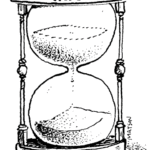Present Tense Simple Verb Forms
Here and Now
 The simple present tense is the most widely used (and the widely misused as well!) of all the verb tense forms.
The simple present tense is the most widely used (and the widely misused as well!) of all the verb tense forms.
Its primary purpose is to indicate that the time frame of the action or state of being is the verb is expressing is limited to the present moment or happens regularly over time.
ZEROING IN
The correct form of verbs expressed in the simple present tense depends on the number and person of the subject.
- First and second person singular or plural: Always he root form of the verb.)
- Third person singular: The root form of the verb—with an “s” following the final letter.)
- Third person plural: (The root form of the verb)
The pen pen (third person singular) is (third person singular form of the verb “to be”) mightier than the sword. (The sentence is expressing an opinion).
The early bird (third person singular noun) gets (root form of “get” with an “s” following the final letter)
Birds (third person plural noun) of a feather flock (root form of “flock”)
PRESENT TENSE CONTINUOUS
Time frame: Actions or conditions that began in the past and are still taking place in the present.
The correct forms:
- First person singular: (“I”) The root form of the verb preceded by “am” and ending with “ing”.
- First person plural: (“we”) The root form of the verb preceded by “are” and ending with “ing”.
- Second person singular or plural: (“you”) The root form of the verb preceded by “are” and ending with “ing”.
- Third person singular: (“he”, “she”, or “it”—or any singular noun) The root form of the verb preceded by “is” and ending with “ing”.
- Third person plural: (“they”) The root form of the verb preceded by “are” and ending with “ing”.
Are you reading any interesting books? (Root form of “read” preceded by the plural verb “are” and ending in “ing”.)
My friend Juan third person singular) is helping (Root form of “help” preceded by the singular verb “is”.) me with my Spanish lessons. (Root form of “help” preceded by the singular verb “is”.)
Two of my closest friends (third person plural) are going (Root form of “go” preceded by “are” and ending in “ing”.) to work with me on my next project.
I have finally received (the past participle form of “received” preceded by “have”.) the package you mailed me last month.
I hope you have enjoyed (The past participle form of “enjoy”, preceded by “have”.) I recommended
FUTURE TENSE SIMPLE
Time frame: Actions or states of being that will take place or be in place in the future.
How to form it: Precede the root form of the verb with either “will” or, in certain situations, “shall”.
PRESENT TENSE PERFECT
Time frame: Two situations: (1) An action that took place or a condition that arose in the past but at no specifically stated time.
The correct forms:
- First person singular: The past participle form of the verb preceded by “have”.
- First person plural: (“we”) The root form of the verb preceded by “are” and ending in “ing”.
- Second person singular or plural: (“you”) The root form of the verb preceded by “are” and ending in “ing”.
- Third person singular: The root form of the verb preceded by “is” and ending in “ing”.
- Third person plural: (“we”) The root form of the verb preceded by “are” and ending in “ing”.